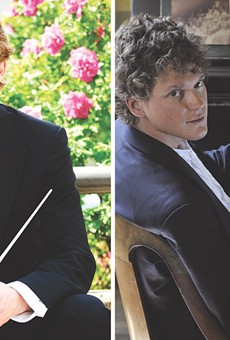Music Blog
Before the concert started Thursday night, I heard a woman say to the man next to her, "If you don't want to stay, we don't have to. It's not like you haven't heard 'Eroica' before."
It's good that they stayed, because last night guest conductor Courtney Lewis led the Rochester Philharmonic Orchestra through a definitive interpretation of Beethoven's monumental Symphony No. 3 in E-flat Major, the "Eroica" symphony.
The RPO has been put through more than its share of guest conductors recently, and the entire next season will feature a different guest conductor for every program. I have had my share of worries and doubts about the situation, particularly because I consider the RPO to be a world-class orchestra with tremendous potential.
What Lewis gave the RPO last night was the workout the orchestra has needed. Lewis found a way to exploit the many strengths of the RPO, from its scintillating pianissimos in the strings to its reverberating fortissimos. Lewis got the musicians off the backs of their chairs, kept their elbows high, and left them walking out the back door of the Eastman wearing child-like grins.
How did he do it?
There were two crucial elements to the success of Lewis and the RPO. First, Lewis set the perfect tempo for the first movement. The "Allegro con brio" (I would translate that as "briskly with brilliance and sparkle") was firmly set at the first measure. This is a long movement, and it requires terrific skill and stamina from conductor and musicians. There was not even the slightest falter in the tempo transitions, the turns of phrase, and the sharp contrasts of dynamics.
Of course, setting that pace for the first movement had me thinking ahead about the tempos for the third and forth movements. Relating the first to the second movement, the "Marcia funebre: Adagio assai" (a funeral march, but not so much so), not too difficult. The third movement was a "Scherzo: Allegro vivace" (a lively Scherzo), which Lewis nicely took at a brisk and elegant pace. With only a single beat between third and fourth movements, Lewis plunged the RPO into the "Finale: Allegro molto" (a finale, with much gusto). It turned out there was still speed, agility, and dynamic range enough to bring the lengthy symphony to a thrilling conclusion.
Which leads me to the second major compliment: Lewis' interpretation of "Eroica," capturing all the glory and the madness of an authentic rendition of the great Herr Ludwig van Beethoven. Too often, a Beethoven composition is performed because it is a "core work." And while those performances might be technically sound and following the markings written on the page, the very soul of the composer is not even considered.
When I interviewed Lewis for our feature article in this week's City Newspaper, Lewis talked about the moment he first hear the "Eroica" and how he carried around the CD and played it until he wore it out. He spoke as if he knew Beethoven as a contemporary, explaining that Beethoven said the "Eroica" was "about me, about expressing my feelings; it's not about me writing a symphony," and Lewis used big, emotional terms like "triumph," "dread," "loneliest music he wrote." All of this came pouring across the stage through Lewis' baton and the RPO musicians.
Also on the program was the Concerto No. 2 in d-minor for Violin and Orchestra, Op.22 of Henri Wieniawski, with violinist Corey Cerovsek. Cerovsek performed on the "Milanollo" Stradivarius (1728), which has been played by, among others, Niccolo Paganini. The Stradivarius violins are so remarkable and memorable that I could not help but compare and contrast it against those used at the RPO by Augustin Hadelich (romantic throughout its range) and Itzhak Perlman (deeper, cello-like). Cerovsek's Stradivarius was unquestionably a high soprano en pointe, yearning to get into the highest notes of the upper ranges of the Wieniawski concerto.
Cerovsek demonstrated his long-standing knowledge and multiple performances of the piece, which he had described to me during his interview for this week's feature in City. He was at once technically capable and sufficiently relaxed to give us his enjoyment of the composer and the work.
The challenge for Cerovsek and Lewis was Cerovsek's intimate knowledge of the work versus a first-time performance for the conductor and the orchestra. In a few spots, the violin and the orchestra had quickly to catch each other. It's a simple matter of familiarity between all the players, and, given the roar that went up from the audience at the end of the performance, I may have been the only one making this note.
The other work on the program was "Remembrances," by American composer Margaret Brouwer (b. 1940). The work was full, warm, and lyrical. It swept across large arcs of sound and color. It made particularly good use of the French horns. In some ways, it reminded me of RPO performances with Conductor Laureate Christopher Seaman and his favored British composers, where I often found myself comparing it to the moods of the North Sea.
The Rochester Philharmonic Orchestra will perform the program again Saturday, April 20, at 8 p.m. at Kodak Hall at Eastman Theatre. Tickets cost $15-$82. For more information visit the RPO website.
